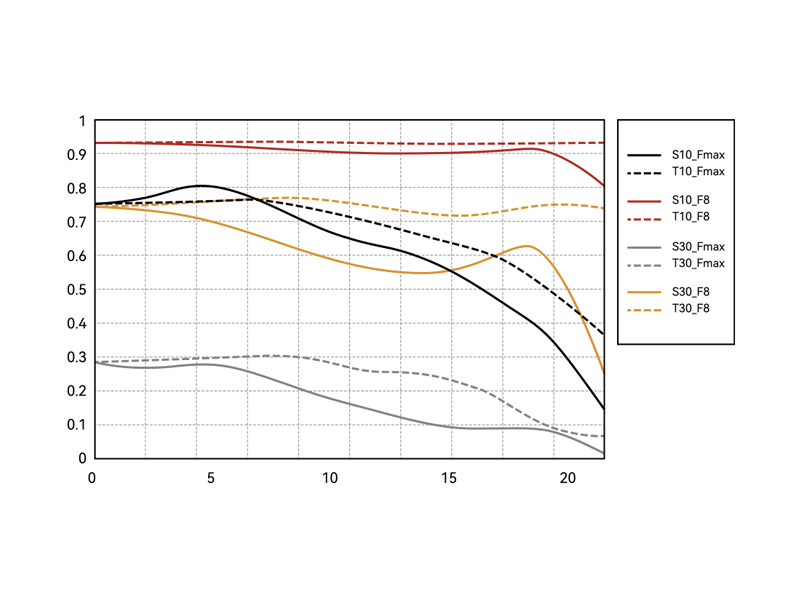







Application Model
SONY E-mount | A7、A7M2(α7II)、A7M3(α7III)、A7M4(α7IV)、
A7R(α7R)、A7RM2(α7RII)、A7RM3(α7RIII)、A7RM4(α7RIV)、A7RM5(α7RV)、
A7S(α7S)、A7SM2(α7SII)、A7SM3(α7SIII)、
A7C(α7c)、A7C2(α7cII)、A7CR(α7cR)、
A1、A9、A9I、A9III、ZV-E1 ,etc. |
FUJI X-mount | X-A1、X-A10、X-A2、X-A3、X-A5、X-A7; X-M1; X-H1、X-H2、X-H2S; X-T1、X-T10、X-T100、X-T2、X-T20、X-T200、X-T3、X-T30、X-T30II、X-T4、X-T5; X-Pro1、X-Pro2、X-Pro3; X-E1、X-E2、X-E2S、X-E3、X-E4; X-S10、X-S20 ,etc. |
Nikon Z-mount | Z5、Z6、Z7、Z6II、Z7II、Z9、Z8、Zf
|
Canon RF-mount | EOS R、RP、R5、R5C、R6、R6 Mark II、R3、R8 ,etc.
|
L-mount | Leica:SL、SL2、SL2-S、SL3 ,etc.
|
MTF & Optical Design


Specification
| Focal length | 50mm | Maximum aperture | F1.4 |
| Closest focus distance | 0.5m | Minimum aperture | F16 |
| Frame | Full Frame | Diaphragm Blades | 13pcs |
| Filter size | 62mm | Optical Design | 7 Elements in 6 Groups |
| Angle of view | 45° | Focus method | Manual |
| Weight | Around 452g | Mount | E / X / Z / RF / L |
Video
The Plane of Focus is in Your Control
As shown in the left figure below, there is no difference between the lens and the regular 50mm f1.4 lens when the tilt function is not used. With a large aperture, only part of the ducks are in focus and the rest of the image is bokeh. As shown in the right figure below, after using the tilt function and without changing the aperture, the focal plane is parallel to the sides of the three ducks, so all three ducks can be shot clearly.

Result without tilt function

Result with tilt function

State of the lens

State of the lens
Partial Focus Function
When taking pictures, we often encounter the need to only make some areas clear and other areas blurred. For example, for the lucky cat, if you want its face to be clear, and the torso to be blurred. If a regular lens is used, since the face and the torso are in the same focal plane, the face and the torso will stay clear at the same time. But using a tilt-shift lens can meet this need without changing the aperture, and making photos more artistic.

F1.4, Result without tilt function

F1.4, Result with tilt function

F1.4 large Aperture
The large-aperture lens brings valuable light in decreases ISO for a more transparent image.
And this beautiful blur provides a refreshing visual effects, which together with the tilt function brings the "Lilliput" effect.
Two Results for the Price of One
A tilt lens can be simply understood as: a conventional lens with a large imaging circle combined with a tilt mechanism becomes a tilt lens. Therefore, when the tilt angle is 0 degrees, it is a conventional 50mm f1.4 large aperture lens that can be used for normal portraits, humanities, sketches and other subjects. In addition, the optical performance is also more guaranteed. Because in the normal state, only the central part of the large image circle is utilized.
Video-Specific Optimization
The video clips from the perspective of "Lilliput" are novel and fun. For more convenient and professional video shooting, the lens has been specially optimized - the focus ring and aperture ring are designed to fit most focus followers in accordance with cine lens.

Fit with the follow focus

De-Click aperture brings smooth change
Tilt Mechanism
A mechanism that tilts the front part of the lens left and right.(more tilt angles can be achieved with the rotating mechanism). Through this mechanism, the angle between the focal plane and the plane of the CMOS can be changed.
Unlock the tilt knob, the lens can be controlled to tilted left and right

Rotation Mechanism
Used in conjunction with the tilt mechanism, the focus can be moved.(The maximum rotation angle of the rotating mechanism is 360 degrees). The rotating mechanism is marked every 15 degrees from 0 to 360 degrees and has a finite point, which allows for more accurate angle control.
Unlock the rotary knob to change the tilt direction

More Details

Tilt lock

Rotation lock

Metal lens cap

Full metal body















